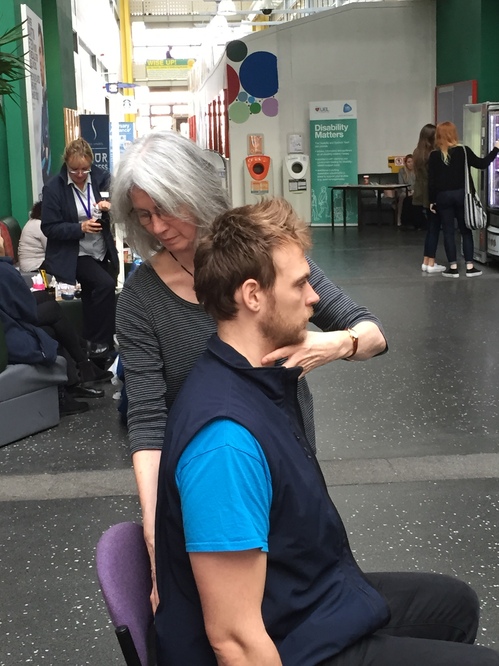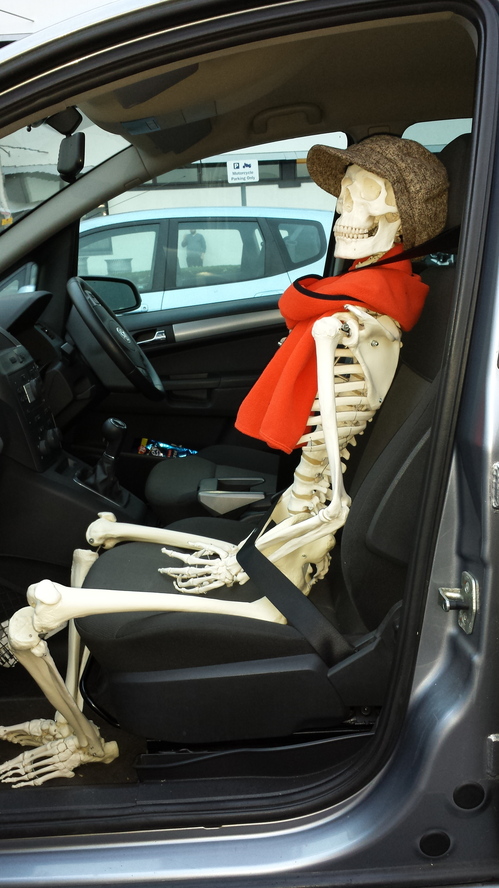As I Say to My Pupils – ‘Pain Can be a Good Teacher’
When we understand the significance of pain and recognise the different types of pain we can experience, we can use pain as a teacher and not just see it as negative. This is particularly true of injuries or aches and pains from tension, which we can feel powerless to change. However, when we listen to our bodies (without becoming obsessive about it)
and develop an awareness of habit patterns which can contribute to or even be the cause of our pain, we can begin to make choices as to how we act and move, and so begin to reduce pain – which helps us gain some
conscious control over the situation..
Of course, some types of pain are an indicator of serious illness or injury and medical attention will be required, but even here we can often use the Alexander Technique to ease the discomfort and to help manage the pain.
Pain from a Broken Toe
Some years back I dropped a heavy piece of wood onto my right big toe and broke the end of it. Although the break was tiny, it was of course, very painful and I walked with a limp for some time, despite my efforts to minimise the distortion in my movements.
After a while, I began to notice that my left knee and right hip joints were beginning to hurt. Thankfully I was already an Alexander teacher and I knew these new pains were developing because of the imbalance created in my
body-use from walking with a limp. I realised that I was continuing to limp even after my toe had stopped hurting – how quickly habits form! When I paid attention to
stopping this habit, my joints stopped hurting. Any subsequent pain indicated to me that I had gone back into the protective limping habit, which I really did not need any more, so I reminded myself to stop that again.
Fear of Pain
After experiencing pain, we often
develop a habit of reacting to the thought of pain by tensing up to protect ourselves ‘in case’ and this tends to be counter-productive. Often these reactions are quite sub-conscious but in Alexander lessons we can learn to recognise them and are then more able to
consciously let go of them .
Reacting by tensing up at the thought of a dentist drilling a tooth for instance, just makes the jaw tighter, more sore and harder for the dentist to move. We can also give ourselves neck, back and head ache if we lie rigidly in the dentist’s chair. Going to the dentist’s is a great time to apply the Alexander Technique! Lying in the chair, reminding ourselves not to tighten our jaw, neck and back can make the experience far more comfortable – and it’s also a good distraction from the process in hand!
RSI Pain
One condition that affects many people these days, including computer-users and musicians, is
Repetitive Strain Injury (RSI) and this is a condition when people often tense up at the thought of being in pain – which just creates more pain. I have taught various pupils with RSI and one of the most helpful things they can do is
attend to the pain they experience, rather than continuing to work through it and to avoid tensing up in reaction to the thought that they will be in pain if they perform a certain action.
By developing an understanding as to which of their actions bring on pain and discovering what it is they do and how they have habitually performed those actions, helps them to realise how they have developed RSI. Then they can learn to avoid unhelpful habits and any pain arising during an activity can show them when they are falling back into the habits that cause problems.
With the help of an Alexander teacher they are then able to learn to:
1) stop a habit and an activity just before any pain kicks in, so that they can avoid creating more pain. Then their bodies can have a chance to recover.
3) learn to challenge the thoughts and attitudes that underlie the overuse patterns they have habitually fallen into. For instance, thoughts such as ‘I must finish this‘, ‘I must continue until I get it right’ or ‘I’m feeling stressed‘ tend to get us to keep pushing ourselves on until there is, consequently, yet more pain. At this point, the quality of our work often deteriorates, so it is far better to stop before this happens!
Completely stopping and
lying down in semi-supine for 10 – 20 minutes can allow our minds and bodies to calm down, unwind and we can let go of our habits of tension that keep driving us on. It also helps injuries to recover and we usually work far better afterwards.
Pain Can be a Valuable Warning Signal
It can be a slow process to learn how to change our reactions and to see pain as a valuable warning signal but this process is one that pays off. It can be used with many conditions such as
back and neck pain, many types of headache and a variety of other strains. An elderly lady came to me for
AT lessons and she had bad arthritis in her knees, so that it was very painful to move into sitting or standing and her knees rather scarily crunched as she moved. However, when she refused to tense up at the thought of moving, she amazed herself by standing up with very little pain – and virtually no noise! When there is deterioration to our bones, the AT cannot change that but when we allow the joints to move more freely, there can be a reduction in the pain experienced. Pain can help remind us to stop, think and then move thoughtfully, freely and much more easily.
In this way, people find they gain a tool they can use to learn from pain, so that they can avoid those habits that help to create pain, This gives them more choices, helps people to regain some power over the situation and often frees them from some or all of the pain that has been one of their teachers.

